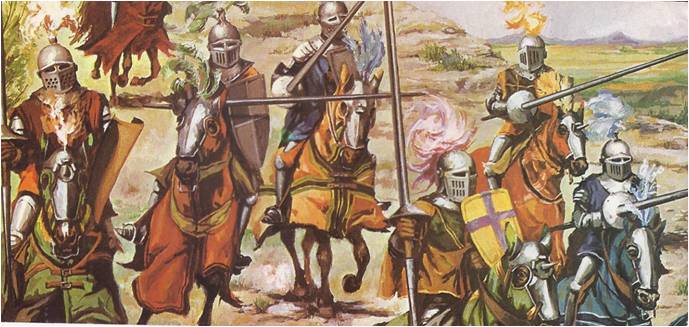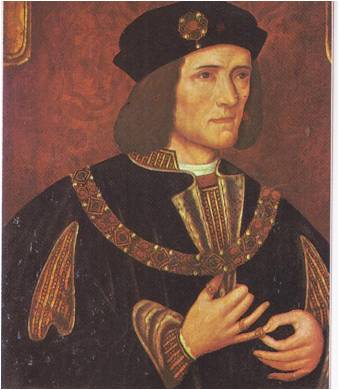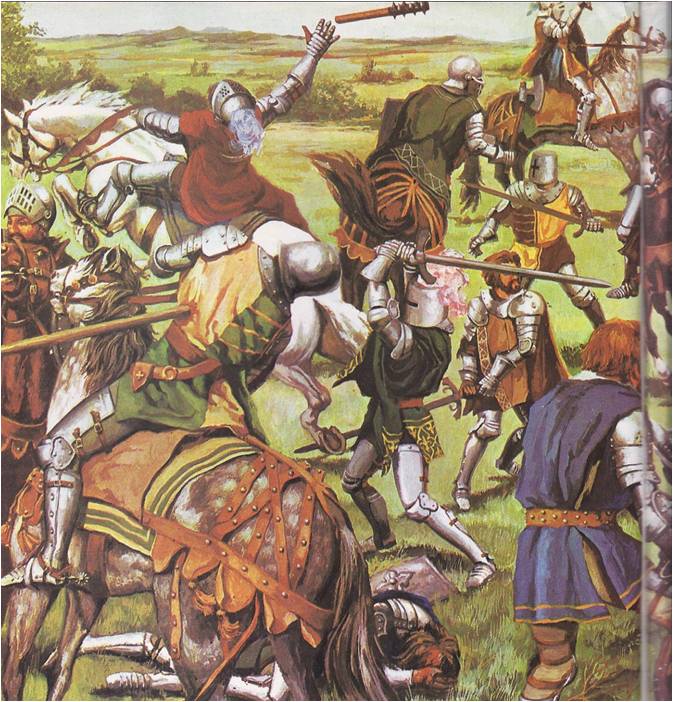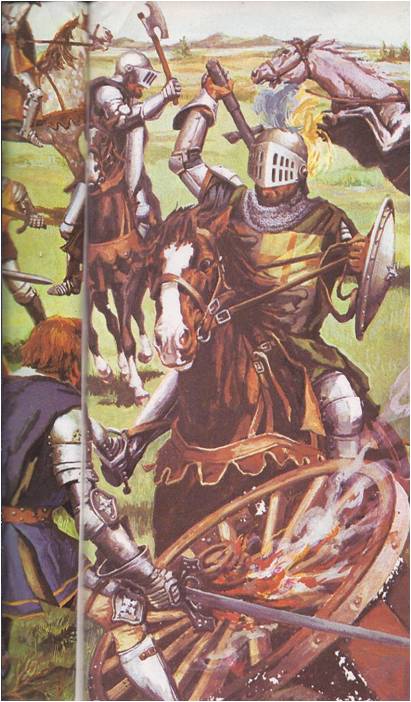JOAN OF ARC did more than inspire the French to drive out the English; her words and actions helped to advance a new idea. During most of the Middle Ages, people did not think of themselves as belonging to a nation. They thought of themselves as members of a church and subjects of a lord. Then, as trade increased, as towns and cities grew‚ as merchants’ and craftsmen’s guilds were formed‚ the forms of society began to change. The barons began to lose some of their power‚ while the kings gained more. Gradually, people begin to think of themselves as part of a nation and a new idea rose — the idea of nationalism.
Joan fought not for a single lord or a single community. She fought for France as a whole, for France as a nation and her allegiance was to the king as head of that nation. It was this, as much as her success on the battlefield that frightened the barons of England and made the nobles of France uneasy. They realized that once the idea of nationalism took hold, feudalism would be done for and they with it.

Nationalism grew stronger as kings grew stronger; a strong monarch unified his people and gave them a feeling of belonging to a nation. The barons did not give up their power easily and often there were rivals for the throne. In England this led to a long period of conflict known as the Wars of the Roses, which from 1455 to 1485. The name came from the emblems of the two families that that fought to rule England. The emblem of the house of York was a white rose; the emblem of the house of Lancaster, a red rose.
The causes of the struggle between the two families went far back into the past. In the year 1272, Edward I of the Plantagenet family came to the throne. As capable as he was ambitious‚ Edward limited the power of his feudal barons, fought two successful wars against Scotland and tried to unite all Britain under his rule. But Edward’s greatest achievement was strengthening and systematizing the law of the land. During his reign, too, began the development of the English Parliament. At first a council of officials and advisers; in time it would become a law-making body of nobles and commoners with more power than the king.

Edward’s son, Edward II, was weak and a poor ruler. In 1314, while he was on the throne, Robert Bruce led the Scots to victory over England in the battle of Bannockburn. Scotland became an independent nation and would not again be joined to England until the seventeenth century.
WARS OF THE ROSES
A third Edward took the throne in 1327. He loved jousting, hunting, making war and was the victor at the battles of Sluys and Crécy in the Hundred Years’ War. His court was one of splendour, with much feasting and pageantry and to his subjects he was everything that a king should be. Edward III was followed by his eleven-year-old grandson, Richard II. His uncles ruled until he was old enough to take the throne himself; when he did, he quarreled constantly with Parliament and his nobles. In 1399, a group of his barons forced him to give up the throne, and young Henry IV, of the house of Lancaster, was made king.

Although Henry owed his crown to the nobles, he had trouble with them through most of his reign. His successor, Henry V, renewed the war with France, partly to keep his nobles busy. His victories, especially the one at Agincourt, made him popular with the people, but he died after reigning for only nine years. His infant son, Henry VI, became king and the child’s uncle, John, Duke of Bedford, was appointed regent.
Without a strong monarch to control them, the nobles were soon very powerful. To get the laws they wanted, they bribed officials and bought Parliamentary elections and orderly government all but broke down. To make things still worse‚ the French, inspired by Joan of Arc, pushed the English out of all their French territories except Calais.
Henry VI was a weak king and the people were discontented. The house of York, led by Richard, Duke of York, plotted to push Henry off the throne and so began the struggle for the crown which was known as the Wars of the Roses. Both, the Yorkists and their enemies, the Lancastrians, raised armies and they fought a bloody battle at St. Albans in 1455. The Yorkists won the battle, but they were unable to push out Henry.
RICHARD III AND THE TUDORS
Five years later, the Lancastrians won a battle at Wakefield and in the fighting the Duke of York was killed. In 1461, Yorkists led by the Earl of March defeated the Lancastrians and King Henry VI was forced into exile. The Earl marched to London at the head of his victorious army and took the throne as Edward IV. After several more battles, the house of York was in full control of the central government.
Edward IV was a popular king, but he died at the age of forty. The throne went to his twelve-year-old son, Edward V and the boy’s uncle, Richard of Gloucester, was named regent. Richard had the boy king and his younger brother held as prisoners in the Tower of London and had himself proclaimed King Richard III. The two boys were smothered to death and most people thought that Richard had ordered the murder to make his reign more secure. For centuries Richard was known as one of the most wicked kings in English history and Shakespeare depicted him as a hunchbacked villain who lived only to do evil. It is only in recent years that historians have begun to doubt that he killed the two young princes; they believe he owes his reputation to the stories spread by his enemies, the Tudors, long after his death.

Evil or not, Richard was unable to control the barons who opposed him and in 1485 Henry Tudor, the Earl of Richmond, came out of exile in France to launch a revolt against him. Henry’s troops met Richard’s at Bosworth Field and the battle ended with Richard dead and his gold crown on the head of Henry.
Henry came to the throne as Henry VII and to strengthen his position married Edward IV’s daughter. He took as his emblem the Tudor rose of red and white, which combined the white rose of York and the red rose of Lancaster. The Battle of Bosworth field marked the end of the Wars of the Roses and the beginning of England’s line of Tudor kings.
It also marked the end of feudalism in England. As a matter of fact, feudalism had begun to die out throughout western Europe. Kings were slowly gaining the upper hand in their struggle for power with the nobles. They encouraged the growth of towns and more and more they looked to the middle class for their trusted advisers and officials. They established royal courts of justice to take the place of the feudal courts and direct taxation to take the place of feudal payments and duties, which often had to be collected by force. They created national armies of paid soldiers and no longer relied on the nobles to furnish troops.
Warfare itself was changing. New weapons and new tactics were making knights in armour, trained for hand-to-hand combat, a thing of the past and this, too, added to the power of the kings. Even more important, manorialism, with its self-sufficient communities, its nobles and peasants and serfs, was breaking down, giving way to the freer society of towns and cities with their merchants and craftsmen.
The Black Death, the great plague that killed perhaps a third of the population of Europe, hastened the end of manorialism. The plague wiped out entire noble families; their lands then went to the kings, who redistributed them.

The rise of trade and commerce offered men new ways of obtaining money, power and led to new classes of society. Merchants and traders helped to spread new ideas, as well as goods, throughout Europe and they needed a strong central authority to ensure law and order. The kings were winning the loyalty of the people, who looked to them for the protection and security that had formerly come only from the feudal lords.
As feudal kingdoms became nations, each with its own identity, customs and language, the spirit of nationalism challenged the unity of the Church. The universal Catholic Church had dominated the early Middle Ages, dictating to king and nobleman and commoner alike. As feudalism declined, the authority of the kings became greater and greater.
With the end of feudalism came the end of the Middle Ages. A new kind of society was in the making, a society that would change Europe’s ways of living, thinking and would bring about new systems of government.





